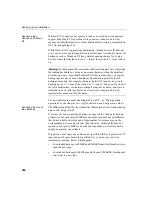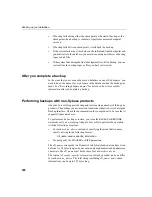
Backing up your database
382
Retaining old disk backups
BACKUP
overwrites existing disk files of the same name. If you need to retain
a backup, when you create a new backup either use different file or path names
for the archive devices, or move the old backup to another location before
starting the backup.
Two ways to run BACKUP
You can run
BACKUP
in two ways:
•
Attended. In attended mode,
BACKUP
assumes that an operator is present,
and prompts you to mount the archive media when necessary. With this
method, you must run
BACKUP
interactively from the command line.
•
Unattended. In unattended mode,
BACKUP
assumes that no operator is
present, and does not issue prompts. Instead, you must make appropriate
estimates of the space required, and set up your devices accordingly. Any
error is considered fatal.
In some cases, you can use third party software to create backups. Such
products can be particularly useful for unattended backups. See “Unattended
backup” for details if you want to run backups when no operator is present.
Note
You can run
BACKUP
from a batch script or procedure, as well as from
Interactive SQL.
Estimating Media Capacity
Before you do a backup, be sure that your archive media has sufficient space.
When you estimate available space on disk or tape, keep in mind these rules:
•
You need enough room for a full backup of the Catalog Store, as well as
the full or incremental backup of the IQ Store. If your Catalog Store holds
Adaptive Server Anywhere data in addition to the Adaptive Server IQ
system tables, you need room to back up this data as well.
•
You do not need to include space for the transaction log, as this log is not
backed up.
•
For tape backups, the first tape set you specify must be able to hold the full
backup of the Catalog Store, including any non-IQ data in the Catalog
Store. (A tape set consists of one or more backup tapes produced on a
given archive device.)
Summary of Contents for Adaptive Server IQ 12.4.2
Page 1: ...Administration and Performance Guide Adaptive Server IQ 12 4 2 ...
Page 16: ...xvi ...
Page 20: ...Related documents xx ...
Page 40: ...Compatibility with earlier versions 20 ...
Page 118: ...Troubleshooting startup shutdown and connections 98 ...
Page 248: ...Importing data by replication 228 ...
Page 306: ...Integrity rules in the system tables 286 ...
Page 334: ...Cursors in transactions 314 ...
Page 396: ...Users and permissions in the system tables 376 ...
Page 438: ...Determining your data backup and recovery strategy 418 ...
Page 484: ...Network performance 464 ...
Page 500: ...System utilities to monitor CPU use 480 ...
Page 514: ...Characteristics of Open Client and jConnect connections 494 ...
Page 536: ...Index 516 ...
















































